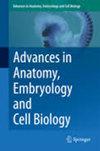不同灵长类动物的颈部组织比较。
4区 生物学
Q3 Medicine
Advances in Anatomy Embryology and Cell Biology
Pub Date : 2018-01-01
DOI:10.1007/978-3-319-70046-5_8
引用次数: 1
摘要
在本章中,我们比较了猕猴、卷尾猴和松鼠猴中钙结合蛋白calbindin和parvalbumin以及神经丝蛋白SMI-32的pulvinar免疫组化染色模式。这群新、旧大陆灵长类动物有5个相似的pulvinar细分:PIP、PIM、PIC、PIL和PILS。在旧大陆猕猴中,根据其与视觉区V1的连通性,可以将其细分为P1和P2。另一方面,在新世界卷尾猴身上只发现了P1区,没有发现P2区。值得注意的是,化学结构的相似性与不同的连接模式和不同的视觉组织形成鲜明对比。本文章由计算机程序翻译,如有差异,请以英文原文为准。
Comparative Pulvinar Organization Across Different Primate Species.
In this chapter, we compare the pattern of pulvinar immunohistochemical staining for the calcium-binding proteins calbindin and parvalbumin and for the neurofilament protein SMI-32 in macaque, capuchin, and squirrel monkeys. This group of New and Old World primates shares five similar pulvinar subdivisions: PIP, PIM, PIC, PIL, and PILS. In the Old World macaque monkey, the inferior-lateral pulvinar can be subdivided into the P1 and P2 fields based on its connectivity with visual area V1. On the other hand, only the P1 field and no P2 was found in the New World capuchin monkey. Notably, the similarities in chemoarchitecture contrast with the distinct connectivity patterns and the different visuotopic organizations found across the species.
求助全文
通过发布文献求助,成功后即可免费获取论文全文。
去求助
来源期刊
CiteScore
2.00
自引率
0.00%
发文量
0
期刊介绍:
"Advances in Anatomy, Embryology and Cell Biology" presents critical reviews on all topical fields of normal and experimental anatomy including cell biology. The multi-perspective presentation of morphological aspects of basic biological phenomen in the human constitutes the main focus of the series. The contributions re-evaluate the latest findings and show ways for further research.

 求助内容:
求助内容: 应助结果提醒方式:
应助结果提醒方式:


